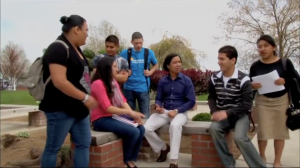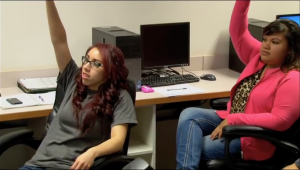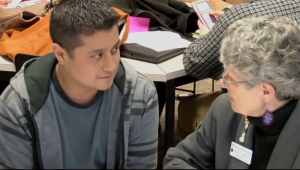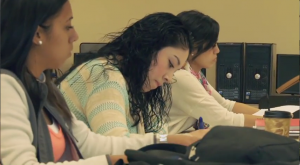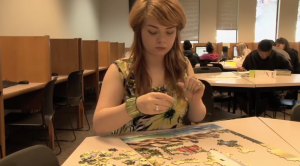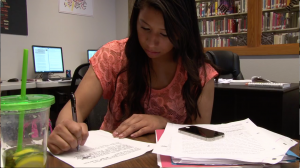Enjoy the excitement of real classroom faculty who are featured in these videos! They’re leading first-generation college students to success and graduation!
Want to learn more about these great strategies?
Check out the research & theories behind them:
Breakthrough Strategies: Classroom-Based Practices
to Support New Majority College Students by Dr. Kathleen Ross
Published by Harvard Education Press – 2016
Additional information including discounts on bulk orders.
Attendance and Classroom Community
The concept of first-generation students’ identities as part of a community of learners is used here to help them appreciate why attending every class and participating fully is important.
A professor explains how he builds his first-generation students’ confidence to produce dramatic results in their active participation in class discussions.
Embracing an Academic Identity
Most first-generation students lack any idea of what it’s like to study at the college level and wonder how they will succeed. This professor helps them recognize and use their talents so they will thrive and persist to graduation.
Employing the theory behind the Ostrom Strategy developed by Claude Steele et al., this professor demonstrates how setting high standards for her students and stating she knows they can meet them can remove their fear of failure and promote their success in her class.
Guided journaling helps students see learning as an active process. This professor explains how she employs guided journaling in her classes to help her students – especially those who are first generation to college – do higher-level thinking and become engaged learners.
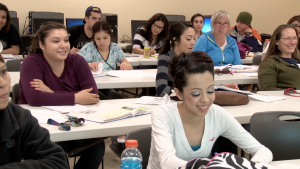 Overcoming Fear of Asking Questions
Overcoming Fear of Asking Questions
Any students can experience some hesitation about asking questions in class, but how can we help those who have been taught not to ask questions in public, or those who are so lacking in self-confidence that they won’t allow themselves to ask questions? This professor shares a strategy that can help even the most timid student develop this essential skill.
 Overcoming Stereotypes by Building Professional Skills
Overcoming Stereotypes by Building Professional Skills
How can students navigate a culture that will stereotype them, especially as they seek to become successful professionals? This professor shares his strategy to help students develop the skills that will help them overcome stereotypes they may encounter.
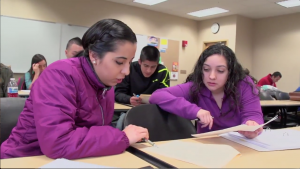 Power Reading for Understanding
Power Reading for Understanding
This professor’s Power Reading Strategy helps students easily identify and grasp new ideas rather than simply looking for something familiar in their assigned readings, which just reinforces prior knowledge.
 Student Engagement Through Textbooks
Student Engagement Through Textbooks
Students, especially those who are first-generation, often expect a textbook to be boring and difficult to understand. This professor employs a strategy that helps them see the value of the information in a textbook and how to use it.
Most first-generation students can’t find the time or a quiet place to study at home. This professor’s strategy helps them plan how to get their demanding coursework done.
 Using A Seminar Format to Engage Students
Using A Seminar Format to Engage Students
In this video, a professor demonstrates how he adapts a traditional seminar format to foster thoughtful discussion in larger classes.
First-generation students are often overwhelmed by the amount of information they have to process and feel disheartened when they don’t do well on exams. This professor explains how she uses analogies with her students to teach them they can stick with a difficult task and succeed.
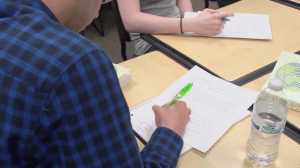 Using the Syllabus to Engage Students
Using the Syllabus to Engage Students
Here, a professor explains how he uses his course syllabus during the first days of class to create an environment that students experience as welcoming, participative, and motivational.
Citing several barriers that first-generation students encounter with college writing assignments, this professor explains how she helps students breakthrough those barriers. One of her techniques involves a ubiquitous but infrequently employed technology.
- Give us your feedback on the videos. The more input we have the more helpful our future research will be!
- Share your own Breakthrough Strategy. We need more great ideas – give us one today.
- Check out this special Reference List for new ideas.
“Attendance and Classroom Community”
- Gohn, L. A., & Albin, G. R. (2006). Understanding college student subpopulations: A guide for student affairs professionals. NASPA Student Affairs Administrators in Higher Education. See especially Chapter 6, p. 115-134.
- Clark, M. (2006). Succeeding in the city: Challenges and best practices on urban commuter campuses. About Campus, 11(3), 2-8.
- Pascarella, E.T., and Terenzini, P. T. (2005). How college affects students: A third decade of research. San Francisco: Jossey-Bass.
- Hirschy, A. S., & Wilson, M. E. (2002). The sociology of the classroom and its influence on student learning. Peabody Journal of Education, 77(3), 85-100.
- Fraser, L. (2012). A Value-Based Approach to Student Success & Building Trust With Your Institution. Career Education Review, 2012, 16 – 21.
“Embracing an Academic Identity”
- Stephens, N. M., Fryberg, S. A., Markus, H. R., Johnson, C. S., & Covarrubias, R. (2012). Unseen disadvantage: How American universities’ focus on independence undermines the academic performance of first-generation college students. Journal of personality and social psychology, 102(6), 1178-1197.
- Gohn, L. A., & Albin, G. R. (2006). Understanding college student subpopulations: A guide for student affairs professionals. NASPA Student Affairs Administrators in Higher Education. (see Chapter 6, p. 115 – 134)
- Tinto, V. (2000). Taking student retention seriously: Rethinking the first year of college. NACADA Journal, 19, 5-10.
- Cohen, G. L., Steele, C. M., & Ross, L. D. (1999). The mentor’s dilemma: Providing critical feedback across the racial divide. Personality and Social Psychology Bulletin, 25(10), 1302-1318.
- Bolin, A. U., Khramtsova, I., & Saarnio, D. (2005). Using student journals to stimulate authentic learning: Balancing Bloom’s cognitive and affective domains. Teaching of Psychology, 32(3), 154-159.
- Hubbs, D. L., & Brand, C. F. (2005). The paper mirror: Understanding reflective journaling. Journal of Experiential Education, 28(1), 60-71.
“Student Engagement Through Textbooks”
- Berry, T., Cook, L. Hill, N. & Stevens, K. (2011) An Exploratory Analysis of Textbook Usage and Study Habits: Misperceptions and Barriers to Success.College Teaching, 59(1), 31-39.
- Hirschy, A.S., & Wilson, M.E. (2002). The sociology of the classroom and its influence on student learning. Peabody Journal of Education, 77(30), 85-100.
- Gohn, L. A., & Albin, G. R. (2006). Understanding college student subpopulations: A guide for student affairs professionals. NASPA Student Affairs Administrators in Higher Education. (see Chapter 6, p. 115 – 134)
- Clark, M. (2006). Succeeding in the city: Challenges and best practices on urban commuter campuses. About Campus, 11(3), 2-8.
- Suthakaran, V., Filsinger, K., & White, B. (2013). Using Analogies as an Experiential Learning Technique in Multicultural Education. Multicultural Perspectives, 15(2), 92-97
- 2. deWinstanley, P. A., & Bjork, R. A. (2002). Successful lecturing: Presenting information in ways that engage effective processing. New Directions for Teaching and Learning, 2002(89), 19-31.
Additional selected readings, related to the video topics and first generation student success.
To view all of the videos, visit our YouTube channel: http://www.youtube.com/HeritageISIS


